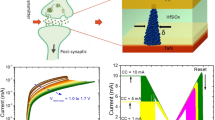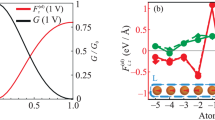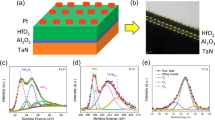Abstract
The need for nano-sized memristive devices as synaptic emulators is increasing day-by-day to build neuromorphic devices on a chip with a large integration density. Therefore, nanoscale fabrication and subsequent device assessment are exigent to make further advancements in the field. In this report, by employing atomic force microscopy, we demonstrate highly dense electronic nano-synapses in filamentary metal oxide-based memristors, wherein the tip works as one of the electrodes. Different metal oxide-based memristors with varying defect concentrations have been studied to demonstrate the efficacy of atomic force microscopy-based local probe techniques in extracting the defect-dependent performance metrics of the same at nanoscale. Some of the basic biological synaptic characteristics such as potentiation/depression and spike’s property-dependent plasticities are accessed through different pulsed measurements in conductive atomic force microscopy mode. The current maps acquired using conductive atomic force microscopy measurements on the films confirm the filamentary resistive switching behaviour to prevail and point towards a possible decrease in the operating voltage with an increase in defects density. Kelvin probe force microscopic analyses, on the other hand, suggest that to improve the switching stability, resistivity of the active medium needs to be optimized. Overall, our results substantiate the efficacy of local probe microscopy-based methods to optimize the performance of memristive synapses at nanoscale for potential application in neuromorphic computing.




Similar content being viewed by others
References
Ielmini D, Wong H-SP (2018) In-memory computing with resistive switching devices. Nat Electron 1:333–343
Wang J, Zhuge F (2019) Memristive synapses for brain-inspired computing. Adv Mater Technol 4:1800544
Ohno T, Hasegawa T, Tsuruoka T, Terabe K, Gimzewski JK, Aono M (2011) Short-term plasticity and long-term potentiation mimicked in single inorganic synapses. Nat Mater 10:591–595
Yan X, Qin C, Lu C et al (2019) Robust Ag/ZrO2/WS2/Pt memristor for neuromorphic computing. ACS Appl Mater Interfaces 11:48029–48038
Kumar M, Singh R, Kang H, Park JY, Kim S, Seo H (2020) Brain-like spatiotemporal information processing with nanosized second-order synaptic emulators; “solid-state memory visualizer.” Nano Energy 76:105014
Lanza M, Wong HSP, Pop E, Ielmini D, Strukov D et al (2019) Recommended methods to study resistive switching devices. Adv Electron Mater 5:1800143
Hui F, Lanza M (2019) Scanning probe microscopy for advanced nanoelectronics. Nat Electron 2:221–229
Saini M, Kumar M, Mandal R, Mitra A, Som T (2021) White light modulated forming-free multilevel resistive switching in ZnO: Cu films. Appl Surf Sci 563:150271
Carboni R, Ielmini D (2019) Stochastic memory devices for security and computing. Adv Electron Mater 5:1900198
Boppidi PKR, Raj PMP, Challagulla S, Gollu SR, Roy S, Banerjee S, Kundu S (2018) Unveiling the dual role of chemically synthesized copper doped zinc oxide for resistive switching applications. J Appl Phys 124:1–10
Hasina D, Kumar M, Singh R, Mollick SA, Mitra A, Srivastava SK, Luong MA, Som T (2021) Ion beam-mediated defect engineering in TiOx thin films for controlled resistive switching property and application. ACS Appl Electron Mater 3:3804–3814
Kumar M, Som T (2015) Structural defect-dependent resistive switching in Cu–O/Si studied by Kelvin probe force microscopy and conductive atomic force microscopy. Nanotechnology 26:345702
Ismail M, Mahata C, Kim S (2022) Electronic synaptic plasticity and analog switching characteristics in Pt/TiOx/AlOx/AlTaON/TaN multilayer RRAM for artificial synapses. Appl Surf Sci 599:153906
Kumar M, Ban DK, Kim SM, Kim J, Wong CP (2019) Vertically aligned WS2 layers for high-performing memristors and artificial synapses. Adv Electron Mater 5:1900467
Kumar M, Lim J, Park JY, Kim S, Seo H (2020) Electric-field-induced healing of inanimate topographies: multistate resistive switching and nano-sized artificial synapse functionality. Appl Surf Sci 530:147190
Roy S, Niu G, Wang Q, Wang Y, Zhang Y et al (2020) Toward a reliable synaptic simulation using Al-Doped HfO2 RRAM. ACS Appl Mater Interfaces 12:10648–10656
Huang HW, Kang CF, Lai FI, He JH, Lin SJ, Chueh YL (2013) Stability scheme of ZnO-thin film resistive switching memory: influence of defects by controllable oxygen pressure ratio. Nanoscale Res Lett 8:483
Nandi SK, Venkatachalam DK, Ruffell S, England J, Grande PL, Vos M, Elliman RG (2018) Room temperature synthesis of HfO2/HfOx heterostructures by ion-implantation. Nanotechnology 29:425601
Ogugua SN, Ntwaeaborwa OM, Swart HC (2020) Latest development on pulsed laser deposited thin films for advanced luminescence applications. Coatings 10:1078
Kim D, Jang JT, Yu E et al (2020) Pd/IGZO/p+-Si synaptic device with self-graded oxygen concentrations for highly linear weight adjustability and improved energy efficiency. ACS Appl Electron Mater 2:2390–2397
Kumar A, Herng TS, Zeng K, Ding J (2012) Bipolar charge storage characteristics in copper and cobalt co-doped zinc oxide (ZnO) thin film. ACS Appl Mater Interfaces 4:5276–5280
Mandal R, Mandal A, Mitra A, Som T (2022) Emulation of bio-synaptic behaviours in copper-doped zinc oxide memristors: a nanoscale scanning probe microscopic study. Appl Surf Sci 606:154860
Younas M, Xu C, Arshad M et al (2017) Reversible tuning of ferromagnetism and resistive switching in ZnO/Cu thin films. ACS Omega 2:8810–8817
Son JY, Shin YH (2008) Direct observation of conducting filaments on resistive switching of NiO thin films. Appl Phys Lett 92:222106
Author information
Authors and Affiliations
Corresponding author
Ethics declarations
Conflict of interest
The authors declare that they have no conflicts of interest.
Additional information
Publisher's Note
Springer Nature remains neutral with regard to jurisdictional claims in published maps and institutional affiliations.
Rights and permissions
Springer Nature or its licensor (e.g. a society or other partner) holds exclusive rights to this article under a publishing agreement with the author(s) or other rightsholder(s); author self-archiving of the accepted manuscript version of this article is solely governed by the terms of such publishing agreement and applicable law.
About this article
Cite this article
Mandal, R., Hasina, D., Mandal, A. et al. Investigation of Defect-Driven Memristive and Artificial Synaptic Behaviour at Nanoscale for Potential Application in Neuromorphic Computing. Proc. Natl. Acad. Sci., India, Sect. A Phys. Sci. 93, 445–450 (2023). https://doi.org/10.1007/s40010-023-00829-9
Received:
Revised:
Accepted:
Published:
Issue Date:
DOI: https://doi.org/10.1007/s40010-023-00829-9




